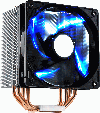
Review: 120mm fan and quad heatpipes
Heatpipe coolers have become pretty common place by now and just about every cooler manufacturer has a selection of coolers with heatpipes these days. Cooler Master has just launched its latest model, the Hyper 212 and we’ve taken one out for a spin to see if it’s any good.
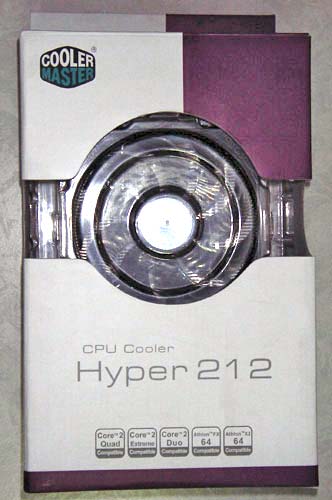
First and foremost, this is a gigantic cooler, it measures 122 x 92 x 160 mm (WxDxH) which might even make it unsuitable for some smaller cases. It’s also quite heavy at 710g, so make sure you don’t throw your case around too much after you’ve fitted it. The Hyper 212 comes fitted with a single 25mm deep 120mm fan, but brackets are supplied for an optional second fan. The pre-fitted fan is black but features blue LED lights. The only downside here is that the fan uses a 3-pin rather than a 4-pin fan connector, as it means it can’t be controlled as well as some other fans.
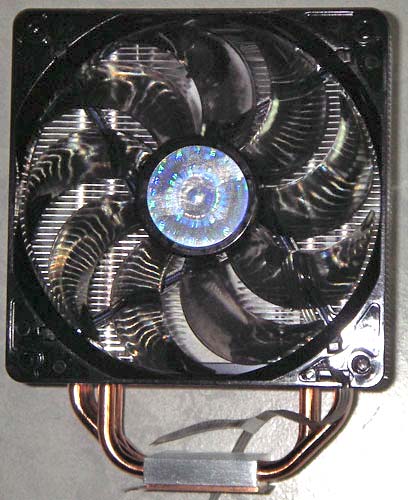
It utilizes four heatpipes and has a copper base plate. The fins on the cooler are made from aluminum and are divided up into two separate sections. This should allow for improved airflow and circumvents most of the “dead zone” that you get from the center of the fan with traditional heatsinks.
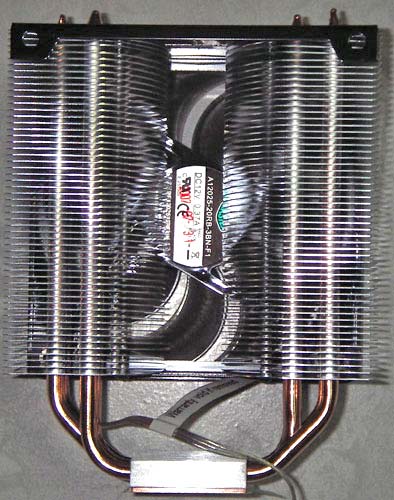
Installation requires you to remove your motherboard, something which is always a real pain, but we can understand why this is the case here, since the Intel pushpin design just hasn’t been designed for these kind of weights. CoolerMaster could’ve made a better design for use with AMD coolers though, since the plastic retention bracket should be more than strong enough to hold this cooler.
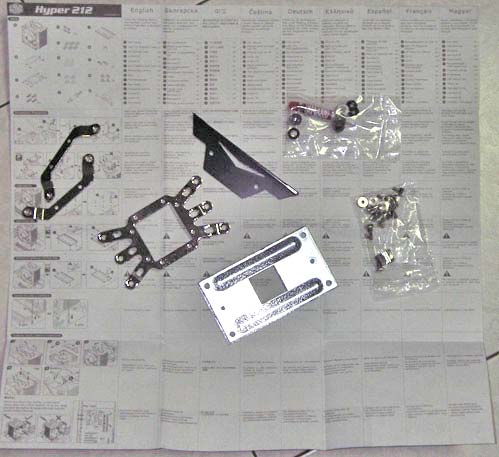
Two different types of mounting accessories were supplied, as the one for AMD processors is universal for all sockets. The extra metal bracket you see in the picture is for the optional secondary fan. The instructions are quite easy to follow and Cooler Master has done a good job of translating them into some 20 different languages. In our case we used the LGA-775 mounting brackets and you have to screw in some special screws with reverse threading into the brackets and then attach a foam grommet around each of the screws to prevent any metal from touching the motherboard.
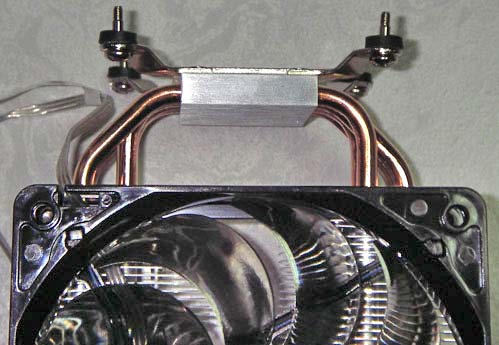
The next step is to apply the thermal grease onto your CPU and we decided not to use the supplied silver coloured paste that Cooler Master supplied. The reason for this was that we wanted to use the same kind of thermal paste as we’d used with the previous cooler in the system, as to keep things as level as possible during testing.
Next you pop the cooler on, flip the motherboard over and fit a small plastic grommet to each of the screws and then attach the four nuts with the help of a clever little gadget that Cooler Master supplies. It turns your screwdriver into a socket wrench, which is quite handy and it allows you to tighten the nuts firmly.
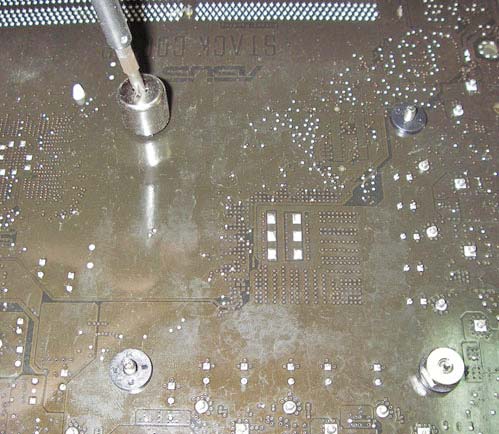
Once that’s done, you simply put your motherboard back into the case and connect everything up. By coincidence, the previous cooler in the system was a Cooler Master Hyper TX, a smaller triple heapipe cooler with a 92mm fan and pushpin fittings. In comparison it’s quite light at 484g and it measures 90 x 44 x 136.5mm (WxDxH).
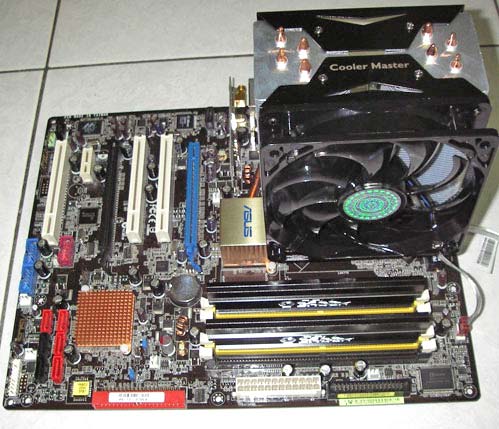
The Hyper 212’s fan is rated at 2,000rpm with an airflow of 69.69 CFM compared to a maximum airflow of 41.76CFM at 1,800rpm for the Hyper TX. The noise level is also meant to be lower at 19dBA compared to 22dBA for the Hyper TX.
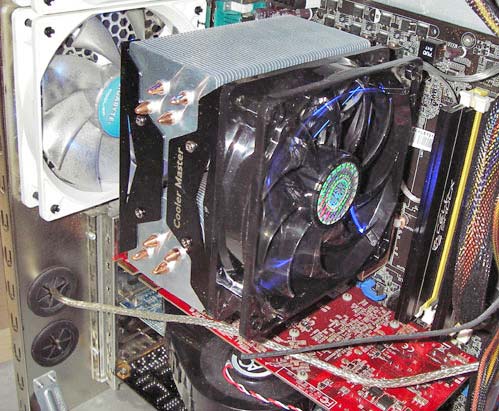
We didn’t really notice any difference in terms of noise, but this could well be because of the other fans in the system drowning the low noise from both of these coolers. In either case, you won’t have to worry about noise. We tested the coolers using an Intel Core 2 Duo E6700 which was overclocked to 3.15GHz on an Asus P5B Deluxe/WiFi motherboard. The case was a Gigabyte Aurora 570 with two rear mounted 120mm fans as well as a Gigabyte Odin GT power supply with a 140mm fan.
It’s pretty clear that the Hyper 212 outperforms the Hyper TX, although maybe not by as much as you’d think considering the extra heatpipe, the larger size and larger, faster fan. In idle the CPU temperature difference was 5 degrees C. Interestingly enough the overall system temperature dropped 3 degrees as well.
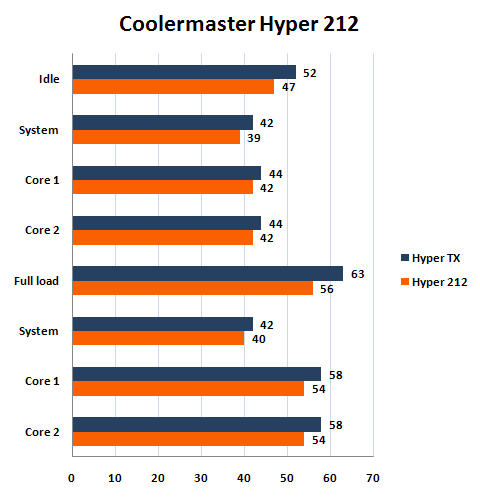
Running two instances of CPU Burn which the error correction disable to produce as much heat as possible cause the Hyper TX to peak at 63 degrees and the Hyper 212 was a whole 7 degrees cooler at 56 degrees. The system temperature difference was also two degrees cooler.
Overall this looks like a pretty decent cooler to us and you can pick one up for around €29 excluding tax which is quite affordable for the performance you get. It’s an excellent cooler for anyone that wants to overclock without the additional noise that it tends to bring with it, but the Hyper 212 is definitely not for the hard core overclockers.
You can find the product page here
